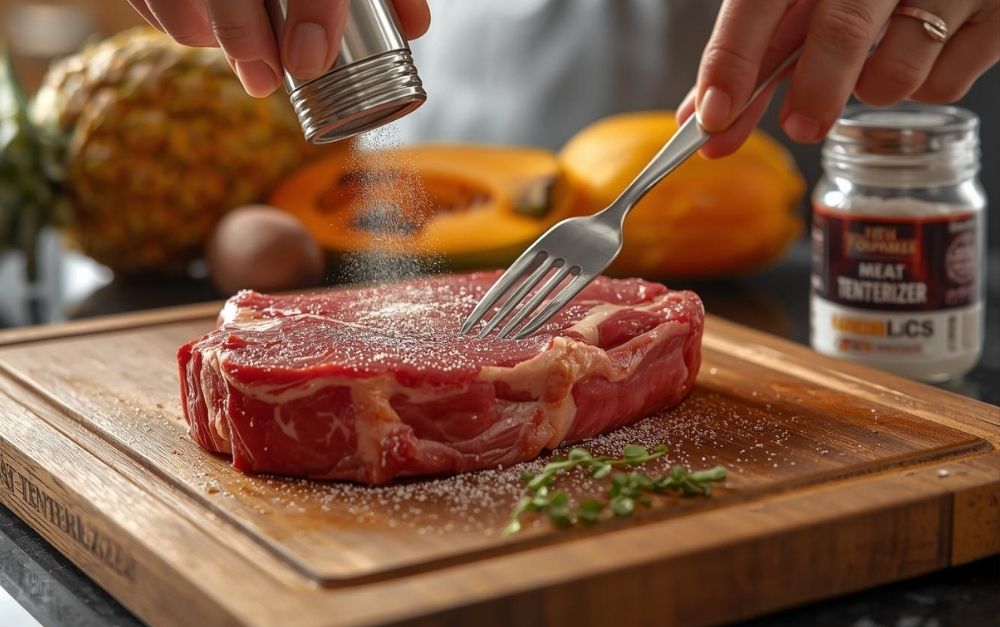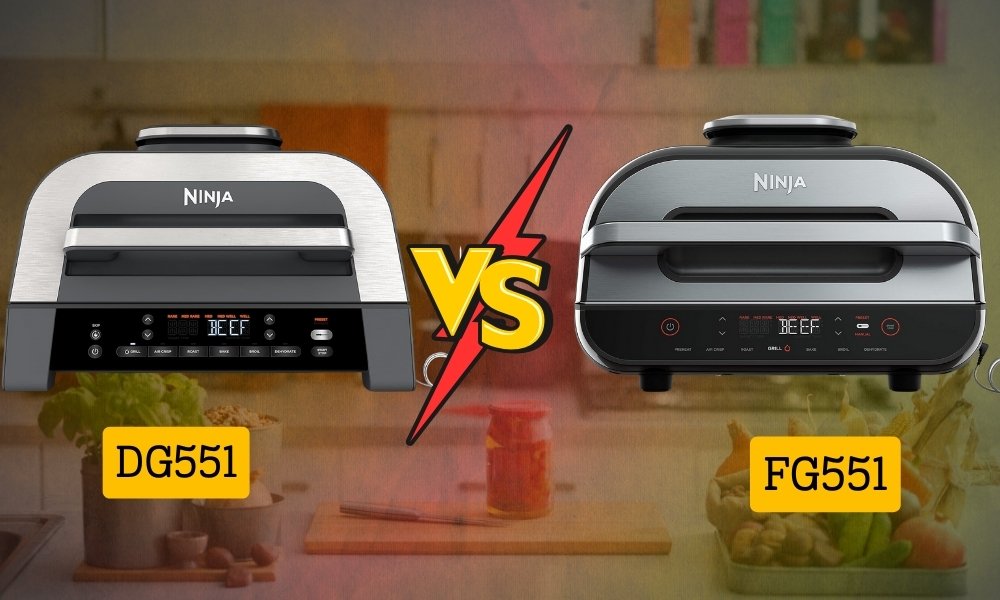Are you tired of eating tough, chewy meat that ruins dinner? You’ve spent time prepping a beautiful steak or pork chop. Only to bite in and feel like you’re chewing on a rubber tire. Sound familiar? You’re not alone. Many home cooks struggle with turning affordable, tougher cuts into something tender and tasty. But here’s the good news: you don’t need a fancy marinade or hours of slow cooking.
In this guide, you’ll learn exactly how to use meat tenderizer powder for perfectly tender meat.The quick, reliable method professional kitchens have used for decades. We’ll break down what tenderizer powder is, how to apply it step-by-step, and share pro tips to avoid common mistakes. You’ll also see how it compares to other methods like baking soda or mechanical pounding.
By the end, you’ll know how to turn even budget cuts into juicy, flavorful meals your family will ask for again and again.
What Is Meat Tenderizer Powder?
Meat tenderizer powder is a dry blend of enzymes and salts. It gently breaks down tough muscle fibers. Think of it as a soft rain easing a dry field.
People have used tenderizing agents for centuries. Ancient cooks used papaya or pineapple enzymes to ease game meats. Today’s powders offer more control and consistency.
You can buy commercial powders or mix your own. Store‑bought brands often add anti‑caking agents. Homemade blends let you adjust flavors and additives.
DIY Meat Tenderizer
Making powder at home is easy. Simply grind dried papaya or pineapple with a bit of kosher salt. Store in an airtight jar. Use it just like store‑bought powder.
Choosing the Right Tenderizer Powder
Look for powders that list “papain” or “bromelain” first. Those are the active enzymes you need. Avoid mixes with artificial colors or excessive sodium. Quality ingredients lead to better results.
Types of Tenderizers
Enzyme‑based powders use natural fruit proteins. Acid‑based blends add citric or tartaric acid for a tangy kick. Both work, but enzymes often give a more even tenderizing action.
Now that you know what it is, let’s dive into how to use it well.
How To Use Meat Tenderizer Powder
To get perfectly tender results you want to start by lightly mistening the surface of the meat with water. This will help the powder adhere and provide a smooth coating. Sprinkling an adequate amount of powder evenly over the meat (1 teaspoon per pound evenly, and piercing with a fork at ½-inch intervals) then gently tap the surface with a fork or with the textured side of a meat mallet, to make shallow holes. Those little holes allow the papain or bromelain enzymes to penetrate further into the fibers.
Next, transfer the meat to a lidded dish and refrigerate for at least 30 minutes before cooking (and up to 2 hours) to allow the enzymes time to soften the chewy strands without turning the texture mushy.Do not add salt. When the time’s up, brush any excess powder off and cook as usual, grilling, searing or roasting over constant heat to seal in the ready-juiced meat. For thicker cuts, tenderize deeper or allow longer resting time.
Lastly, clean all cooking utensils and surfaces that touched the raw meat and powder in order to keep your kitchen safe and clean. if you face problem till now,see the vedio
Common Myths and Misconceptions About Meat Tenderizer Powder
Safety Precautions
Always wash your hands after handling raw meat. Clean any utensils that touched the powder. Keep your work area free of cross‑contamination. Safety first keeps dinner worry‑free.
Best Meats for Tenderizing
Tougher cuts like flank, skirt, and round steak benefit most. Chicken thighs and pork chops also work well. Fish and delicate poultry rarely need tenderizer. Pick robust cuts for best results.
Common Mistakes to Avoid
Avoid over‑seasoning with salt. Enzyme powders often include sodium. Too much salt leads to a harsh taste. Also, don’t skip the rest time. Short rests limit enzyme action.
Pro Tips for Best Tender Results
Use a fine‑mesh shaker for even coverage. Try combining it with garlic powder or herbs. Test one small piece before doing the whole roast. Adjust rest time based on cut thickness.
What Is Meat Tenderizer Powder Made Of?
Most formulas rely on papain from papaya. Papain gently snaps apart protein strands. It’s similar to tiny scissors slicing fibers.
Bromelain from pineapple is another popular enzyme. It works slightly faster than papain. Together, they offer balanced tenderizing power.
Many blends add salt and di‑calcium phosphate. These help the powder flow freely and stick to meat. Anti‑caking agents prevent clumps in humid kitchens.
Allergy and Dietary Considerations
Check labels if you have fruit allergies. Papain and bromelain can trigger reactions in sensitive people. Choose acid‑based powders if needed. Always read the ingredient list.
Storage Tips for Tenderizer Powder
Keep your powder in a cool, dry place. Moisture kills enzyme activity. An airtight jar with a tight lid works best. Use within six months for peak strength.
Reading Labels Effectively
Look for “enzyme activity” or “fruit extract” on the label. Avoid powders with fillers like corn starch. Pure enzyme blends work faster. Quality labels lead to consistent results.
Benefits Of Using Meat Tenderizer Powder
Meat tenderizer powder turns tough cuts into soft bites. It speeds up cooking times. It also helps flavors sink deep into the flesh.
- Improved tenderness in under an hour.
- Faster cooking with less dry edges.
- Enhanced flavor absorption.
- Cost savings by using cheaper cuts.
- Versatile use on beef, pork, and poultry.
I once used tenderizer powder on a tough flank steak. After 45 minutes of rest, it cut like butter. My family asked for seconds and the recipe became a weeknight staple.
Compared to long marinades, powder is a quick fix. You get reliable results without hours of planning. It’s the secret tool for home cooks on busy nights.
A final tip: always adjust based on taste tests. Start light and increase as you go. This keeps your dishes perfectly tender every time.
Powder vs. Mechanical & Baking Soda Methods
Not everyone loves powders. You might try a mallet or baking soda instead. Here’s how they stack up.
Mechanical Methods
Using a meat mallet flattens and tears fibers. It works instantly but can create uneven patches. Over‑beating may turn meat mushy.
Baking Soda Method
Baking soda raises the pH on the surface. This helps proteins relax. You need to rinse thoroughly, or you’ll taste a soapy note.
Powder Method Strengths
Powder offers even, controlled tenderizing. It won’t tear meat or leave odd flavors. Enzymes act gently over time.
Time and Effort Comparison
Mechanical pounding takes under a minute but needs muscle. Baking soda method needs a 15‑minute rest and a rinse. Powder takes 30–60 minutes hands‑off.
Cost and Accessibility
Meat tenderizer powder is budget‑friendly and widely sold. Mallets are a one‑time tool purchase. Baking soda is cheap but less effective on very tough cuts.
- Powder gives consistent texture every time.
- Mallets can damage thin or delicate pieces.
- Baking soda requires precise timing and rinsing.
Overall, powder wins for ease and reliability. Mechanical tools and baking soda still have their place. But if you want something simple, go with the enzyme approach.
Meat Tenderizer Powder Side Effects
Although meat tenderizer powder is generally safe when used correctly, a few minor side effects can occur. For example, overusing enzyme-based powders like papain or bromelain may leave an odd aftertaste, and allowing the meat to rest with too much powder for too long can result in an overly soft, mushy texture. Moreover, creating small punctures with a fork or mallet to help the enzymes penetrate may cause juices to escape, leading to drier meat once cooked.
In addition, individuals with sensitivities to papaya or pineapple proteins should proceed with caution, as allergic reactions—such as hives, itching, or respiratory symptoms—can occur upon contact or ingestion. A 1988 NIOSH health journal report documented cases of meat-processing workers who experienced wheezing and shortness of breath related to airborne papain exposure, underscoring the importance of good ventilation and masks in professional settings. CDC
Furthermore, some people may notice mild digestive upset if they’re particularly sensitive to the enzymes or other ingredients in commercial blends. It’s also worth noting that papain supplements are more potent than culinary powders and, if misused, can rarely cause throat irritation or esophageal discomfort.
Finally, while not an enzyme tenderizer, misapplied baking soda can impart a metallic taste if not thoroughly rinsed off before cooking. Therefore, always follow recommended guidelines—use only the suggested amount, stick to a 30–60‑minute rest time, and thoroughly clean any utensils and surfaces that touched raw meat or tenderizer powder to maintain kitchen hygiene
Conclusion
Learning How to Use Meat Tenderizer Powder for Perfectly Tender Meat unlocks new kitchen wins. You’ll turn budget cuts into gourmet bites. The steps are simple, and the payoff is huge.
Try the powder method on your next roast night. Share the results with friends and family. Soon, you’ll wonder how you cooked any other way.
With thoughtful use, tenderizer powder becomes your trusted helper. Keep a jar on the spice rack. Enjoy juicy, tender meat every time you cook.
FAQ
How Do You Use Meat Tenderizer Powder?
To use meat tenderizer powder effectively:
1.Moisten the Meat: Lightly wet the surface of the meat with water to help the powder stick.
2.Apply Evenly: Sprinkle about 1 teaspoon per pound of meat. Use a fine shaker for best distribution.
3.Pierce the Meat: Use a fork to poke shallow holes about every half inch. This allows the enzymes to penetrate deeper.
4.Rest Time: Let the meat sit for 30 minutes to 2 hours in the fridge, depending on thickness.
5.Cook as Usual: After tenderizing, brush off excess powder and cook using your preferred method—grilling, roasting, or searing.
Do You Have to Rinse Off Meat Tenderizer?
Yes, you should rinse off meat tenderizer powder, especially if using baking soda, before cooking. Rinsing removes excess tenderizer and helps prevent a metallic taste or texture changes
Why rinse?
To remove residual powder.
To avoid metallic or bitter flavors.
To prevent overly soft or mushy texture.
Rinse under cold water, gently rub the surface, and then pat the meat dry before seasoning or cooking.
Do You Put Meat Tenderizer on Before or After Seasoning?
Apply meat tenderizer before seasoning. Here’s why:
The enzymes need to penetrate the raw meat to break down tough fibers.
Seasoning too early may interfere with enzyme action.
After tenderizing and rinsing, you can then add your preferred spices and marinades.
Does Meat Tenderizer Powder Really Work?
Yes, meat tenderizer powder is a proven and effective way to soften tough cuts of meat.
It uses natural enzymes like papain (from papaya) or bromelain (from pineapple) to break down muscle fibers.
Works best on beef cuts like flank, round, or skirt steak, and also on pork and chicken.
Speeds up cooking time and improves flavor absorption.



